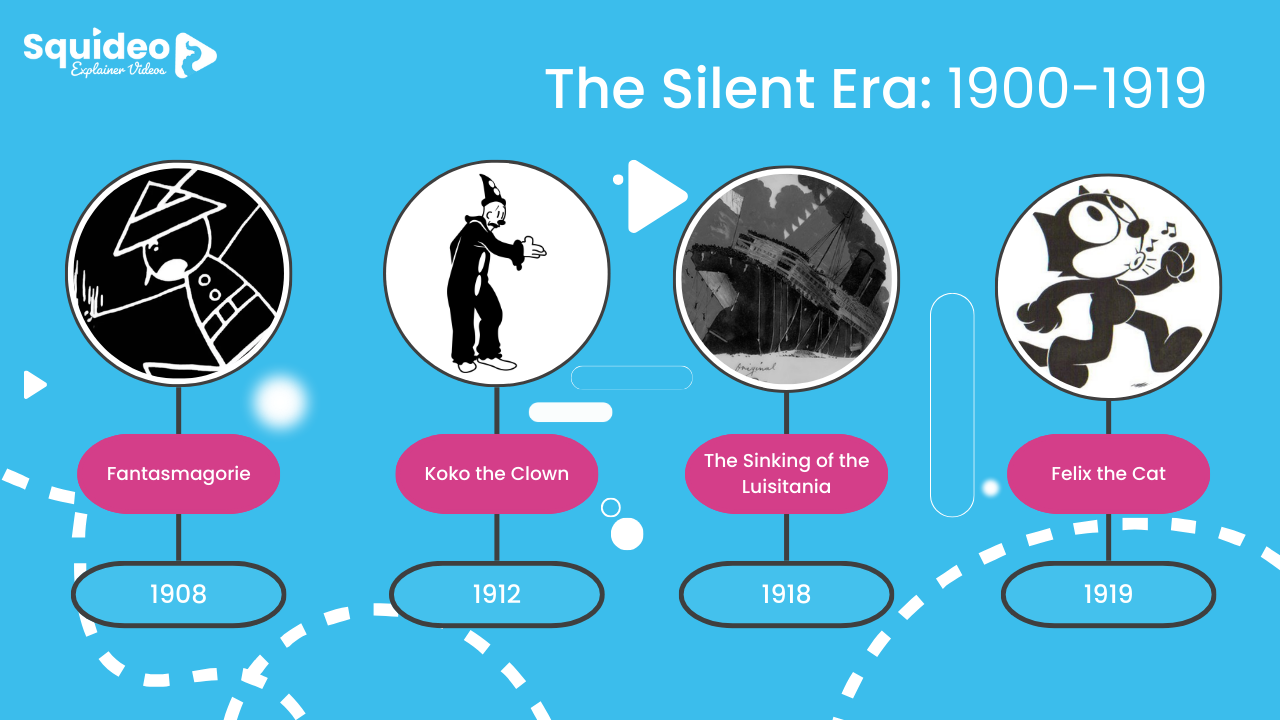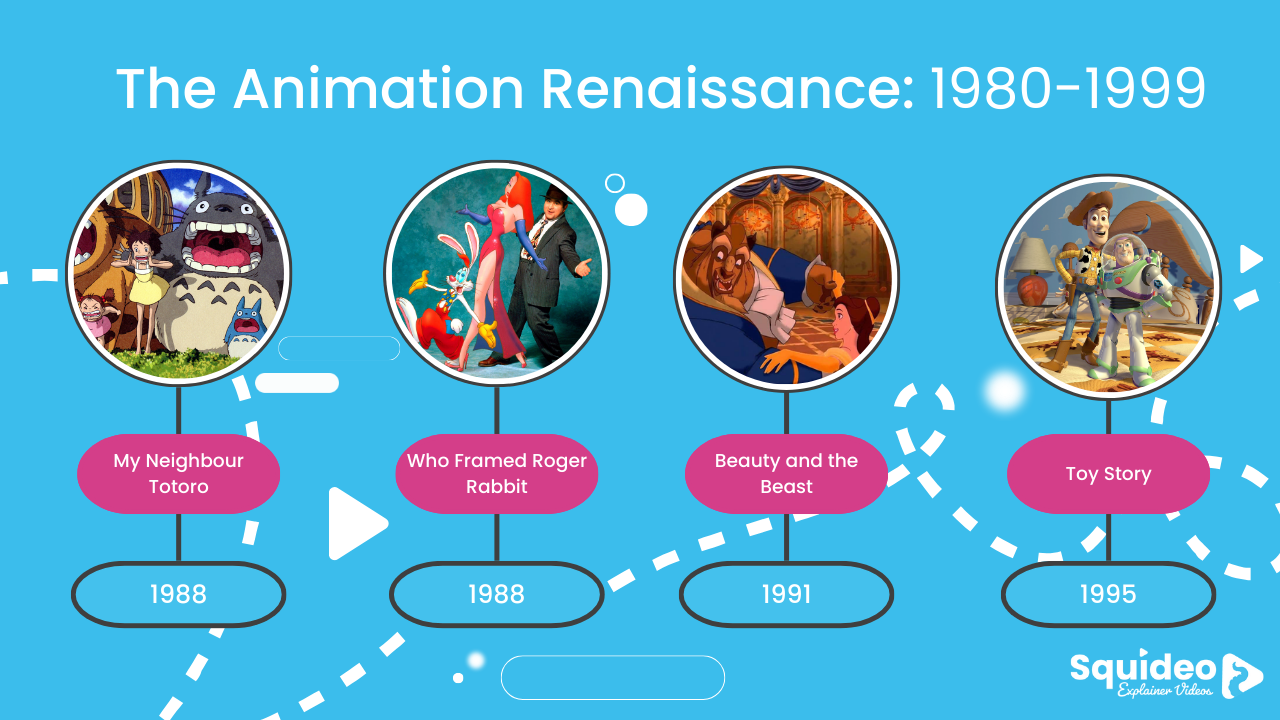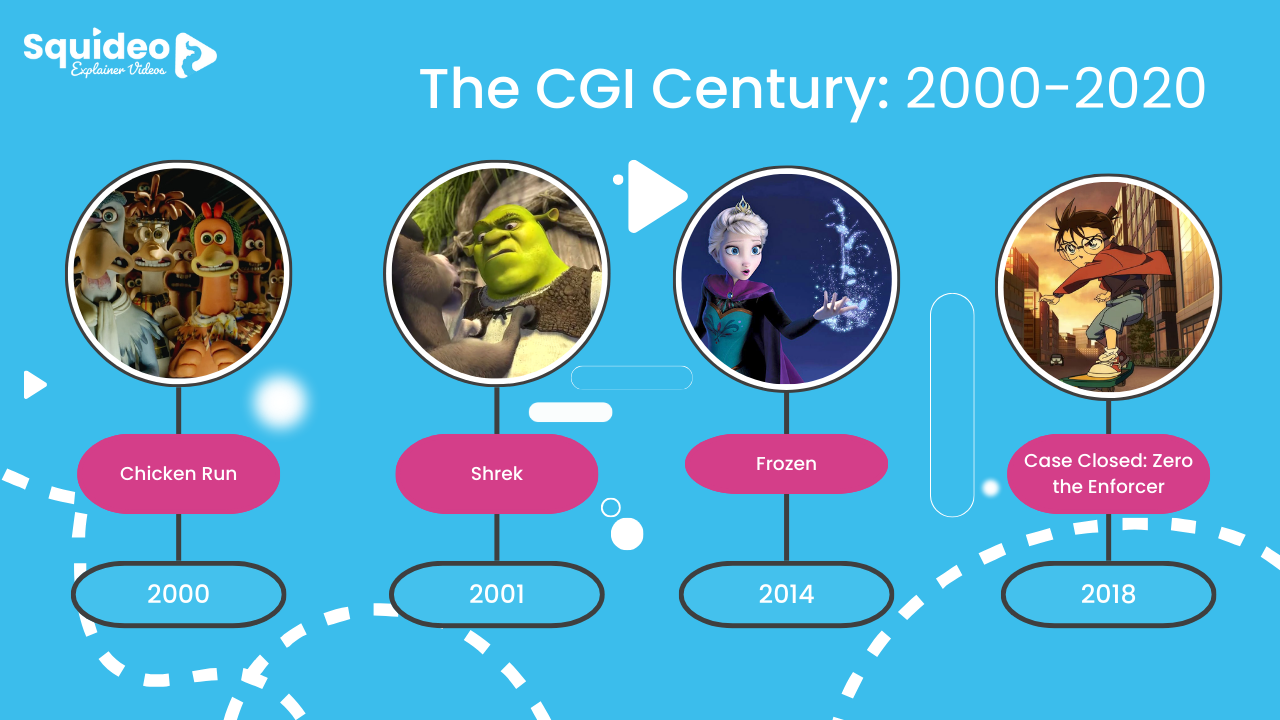The Evolution of Animation: From Classic Cartoons to Modern CGI
It’s hard to pin the invention of animation on a single date. Film archivists have estimated that more than 90 percent of films made before 1929 are lost forever, which makes it almost impossible to say with any certainty which first can be credited to which film.
Multiple techniques, developments and technologies were instrumental in the creation of animation as we know it today. And this progression has continued, with more variations created every decade since the 1900s. Squideo is going to dive into the evolution of animation, from its murky beginnings to the multibillion dollar industry it has become.

The first animated film has been credited to multiple titles, including Pauvre Pierrot (1892), The Enchanted Drawing (1900), Fantasmagorie (1908) and Gertie the Dinosaur (1912). The names of other films have been listed in newspapers from the time, but since they’ve been lost these cannot be verified.
Like live-action films of the time, these early hand-drawn animation films were silent. They would be shown in cinemas or, as in the case of Winsor McCay’s Gertie the Dinosaur, at circuses and vaudeville acts. Animators of this age were working without the later constraints of studios or censorship, and had a lot of freedom to develop new animation styles and techniques.
The realism of early animation was greatly improved by the invention of rotoscoping, first showcased in 1912’s Koko the Clown by Max Fleischer. The rotoscope technique traced motion picture footage of a human performer, and is still used to this day albeit with the use of a computer rather than manually tracing film frames.
Animation improved rapidly within these twenty years, and this is perhaps best demonstrated with The Sinking of the Lusitania (1918), by Winsor McCay. The detail from this film, which was the longest made at that time (12 minutes) and the first confirmed example of an animated documentary, was vastly improved from his first because of the introduction of cel animation. This is named after the celluloid sheets which replaced paper in the animation process, and saved animators the time of creating multiple drawings of backgrounds and stationary objects.
The realistic animation style of McCay’s film, which was widely praised, was quickly eclipsed however by a new style which swept across the American animation industry: rubber hose animation. This debuted in 1919 when Pat Sullivan and Otto Messmer created Felix the Cat.

Felix the Cat was a huge draw for 1920 cinema goers, becoming a hugely popular character which featured in 89 animated cartoons between 1919 and 1925. However the creators’ reluctance to embrace sound film technology, which was debuted in 1923, saw the ultimate decline of Felix and paved the way for Disney’s eventual domination of the American animation industry.
Despite sound technology emerging early in the decade, it took time for animators to adapt it into their work. Some of the most notable animated works of the period are still silent, such as the first claymation film, Long Live the Bull (1926), and the first feature-length animated film: The Adventures of Prince Achmed (1926). Created by Lottie Reiniger, this silhouette animated film famously introduced the multiplane camera which the Walt Disney Company would later reinvent and use for their first feature-length film Snow White and the Seven Dwarfs (1937). It was Disney which arguably popularised sound in animation, with their animated short Steamboat Willie (1928).
Walt Disney was convinced that sound technology would change the future of film, and was the secret to making his new animated character – Mickey Mouse – a hit with audiences. He was right, which imbued the company with the confidence to use other animation technologies that emerged. Five years later, Disney became the first animation company to use Technicolor when it released Flowers and Trees (1932).
Disney’s style began to dominate animation, especially in America. For the smaller studios that lacked their budget and workforce, there was a desire for a different animation style that could be made faster and cheaper. Limited animation was the solution, and it ushered in a new era.
Warner Brothers Animation launched in 1933. It would soon become notable for its Looney Tunes series, but it was Merrie Melodies that brought in limited animation. This technique reduced the number of drawings required for each frame, in turn reducing the work for animators and speeding up the production process. It was ideal for television, a burgeoning medium post-WW2, which had smaller screens than cinemas. The Dover Boys at Pimento University (1942) was one of the first notable uses of the technique.

A lot of innovation during this next period occurred in television production, and it also saw the rise of amateur productions as filming equipment became more readily available to the public. Changing technology additionally created a divide between film and television animation which had differing styles and quality standards during these decades.
Disney was the first studio to use CinemaScope for its animated short Toot, Whistle, Plunk and Bloom (1953). Created by 20th Century Fox in that same year, it remained popular until its discontinue in 1967. This changed the aspect ratio of productions to accommodate wider, rectangular cinema screens. Television screens on the other hand were small and square. And at the start of the 1950s, many households still only had black and white televisions. This was perfect for limited animation, masking the reduction in animation quality. Television ownership grew rapidly through the decade, and producers started investing in cartoons.
The first animated TV series was Crusader Rabbit (1949), followed by shows more familiar to modern audiences like The Woody Woodpecker Show (1957), Captain Pugwash (1957), Yogi Bear (1958), and a reappearance from Felix the Cat (1958). The first animated show to make it to prime-time was The Flintstones, which ran from 1960 to 1966. These shows were more specifically targeted at children: referred to as cartoons rather than animated television. Created by the most successful cartoon studio of the era – Hanna-Barbera (1957-2001) – The Flintstones was followed by hits like Top Cat (1961), Wacky Races (1968) and Scooby-Doo, Where Are You? (1969).
Animated films, however, were marketed as motion pictures. By the end of the decade, animation studios had started to use xerography animation – first trialled in Sleeping Beauty (1959), then fully used in One Hundred and One Dalmatians (1961). Disney’s Ub Iwerks had adapted the Xerox process, first introduced during WW2, to work on film. This copying technique allowed animator drawings to be printed directly onto cels, massively speeding up the production process. This technique was used throughout the 1960s and 70s and other animation studios adopted the technology.
New technology also became available to the general public. The commercially successful Super 8 camera launched in 1965, and amateur animators were able to record their own cartoons. This inspired new animation styles, such as brickfilming. Journey to the Moon (1973) was the first recorded of its kind, and paved the way for future animated films like The Lego Movie (2014).

At the start of the 1980s, ‘Saturday morning cartoons’ were flourishing while animated motion pictures were in decline. This was perhaps best exemplified by Disney, who launched Disney Television Animation (1984), while the Walt Disney Animation Studios had its budget slashed. One of its most popular 1980s films, Who Framed Roger Rabbit (1988), was created by an animation department which had just been sent into exile from the main studio lot.
Likewise, the other Big Five production companies started focusing on television animation. Paramount Studios created Nickelodeon (1977) and Warner Brothers Cartoons shifted to create television content. This unit would later become Cartoon Network Studios (1994). The biggest television cartoon to emerge from this period is The Simpsons, which first aired in 1987 on The Tracey Ullman Show, and is one of Fox Broadcasting Company’s biggest assets.
This did leave space for overseas animation companies, most notably the Japanese Studio Ghibli, to find the spotlight with English-speaking audiences. Castle in the Sky (1986) and My Neighbour Totoro (1988) were both critically acclaimed. Likewise, Aardman Animation – the British claymation studio – rose to prominence with its work on the Peter Gabriel Sledgehammer (1986) music video which paved the way for its Creature Comforts and Wallace and Gromit series in the 1990s. Universal Pictures also launched DreamWork Pictures in 1994, releasing its first film Antz in 1998, and would become a big player in the 2000s.
Arguably the most successful studio to emerge was a small computer division originally created by Lucasfilm in 1979. Pixar pioneered 3D computer animation which they first publicly debuted in The Adventures of André & Wally B (1984). They would go on to make the first 3D computer animation feature film, Toy Story (1995), with Disney – although they were beaten in television by Canadian studio Mainframe Entertainment’s ReBoot (1994).
Disney was already developing digital production techniques such as its Animation Photo Transfer (APT) process was first used in Black Cauldron (1985). Their partnership with Pixar, formalised in 1991, massively improved this digitalisation; most notably with CAPS. First used in The Rescuers Down Under (1990), the Computer Animation Production System provided a host of new digital tools to animators, and kickstarted the Disney Renaissance.
This produced massive hits, not just for Disney but also breaking global box office records. The success of their films, especially The Lion King (1994) prompted their rivals to revive their own animated feature film projects. Other animated feature hits of the 1990s included Space Jam (1996), Anastasia (1997), Antz (1998), The Rugrats Movie (1998) and The Iron Giant (1999).
The highest-grossing hits of the 1990s belonged to Disney and Pixar with the top five films being The Lion King (1994), Aladdin (1992), Toy Story 2 (1999), Tarzan (1999) and Beauty and the Beast (1991). The latter film also became the first animated film to be nominated for the Academy Award for Best Picture.
Alongside 3D computer animation, computer-generated imagery (CGI) was growing in popularity for live-action films. First appearing in Westworld (1973), it opened the door for creators. In 1999, the latest CGI trend – motion capture animation – was used to add the first fully animated character into a live-action picture. While Jar Jar Binks wasn’t the biggest hit, Star Wars: The Phantom Menace (1999) proved to be a turning point for computer animation as the new century began.

CGI and 3D computer animation has permanently changed animation. Few films over the past twenty years were created using the traditional hand-drawn 2D animation process, although they still proved popular with audiences. This included the French film Les Triplettes de Bellville (2003), Spain’s Klaus (2019), Japan’s Ponyo (2008) and America’s The Simpsons Movie (2007). All of these films still use digital animation tools to streamline production and minimise costs.
What these changes mean, however, is that animation is no longer ruled by the largest corporations with the largest animation departments. Small teams of animators can create quality feature films using the available technology, and this has propelled the growth of small production studios. The introduction of streaming platforms has also widened the viewership for international animation.
Japanese animation, particularly in the anime style, has benefited from this. While Japanese studios gained a foothold with western audiences in the late 1980s, it has recently catapulted in popularity. Netflix reported that 50 percent more households around the world watched at least one anime title during the first nine months of 2020 compared to the whole of 2019. Studio Ghibli remains the most successful export, continuing its success with Spirited Away (2001), Howl’s Moving Castle (2004) and The Tale of Princess Kaguya (2013) to name a few. More studios are joining their ranks, such as the record-breaking MAPPA, WIT Studio, Madhouse and CoMix Wave Films.
Other non-American studios that are benefiting from the decentralisation of the animation industry include Aardman Animation, Les Armateurs, BreakThru Films, The SPA Studios and Cartoon Saloon. American animators have also broken away from the studio system. LAIKA was created following the success of A Nightmare Before Christmas (1993), this studio has since released Coraline (2009) which is America’s highest-grossing stop-motion film.
Many of these films are still distributed through large American companies or made in partnership with them. Illumination Studios, the makers of Despicable Me (2010) and The Grinch (2018), was incorporated into a Universal Pictures division almost as soon as it was founded. And Aardman Animation’s stop-motion feature film Chicken Run (2000) was made with DreamWorks Animation, a unit of Universal Pictures.
Since its first film in 1998, DreamWorks has gone on to create two of the most profitable animated franchises: Shrek and Madagascar. Shrek (2001) helped define the future of DreamWorks and its aim to become the antithesis of Disney – an interesting goal considering it was co-founded by a former Disney chairman, Jeffrey Katzenberg, and Disney collaborator, Stephen Spielberg. Shrek modelled its characters after their celebrity voiceover artists; it ditched original scoring for pop songs; and it leant into juvenile humour.
Disney – which purchased Pixar Animation Studios in 2006 – continued to make 2D style animation at the beginning of the 2000s. With the rising success of other 3D animation features like Toy Story and Shrek however, this was phased out. Disney’s last 2D animated feature film to date was Winnie-the-Pooh (2011), and its last 2D Disney Princess was Tiana in Princess and the Frog (2009).
Disney hasn’t ruled out a return to 2D animated features and, for its 100th anniversary celebrations, has created new 2D animated shorts which resurrect original characters like Oswald the Lucky Rabbit.
As one of the oldest animation studios in existence, it feels natural to look to Disney for an indication where the industry is heading in the 2020s. But as the past thirty years have proved, the industry has become a more even playing field where anyone can succeed.
Work With Us
Ready to create an animated video of your own? Watch the video below to get a better understanding of how Squideo can help promote your business, then get in touch with us to find out more!













